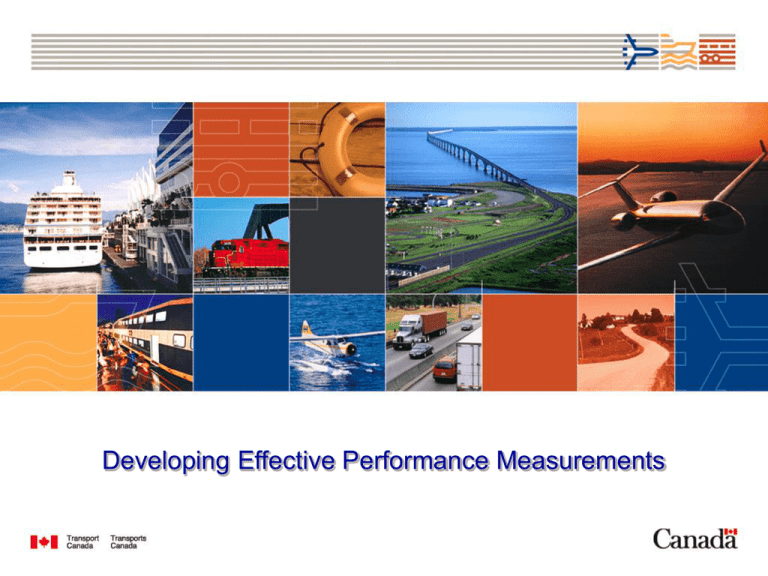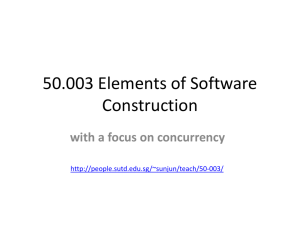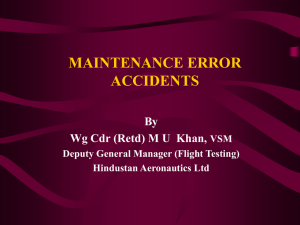WHAT MESSAGES ARE IN THIS EXPERIMENT?
advertisement

Developing Effective Performance Measurements Introduction- The Theme Begin to Think Differently About Performance Measurement Using • Why You Need to Measure • How You Can Measure with a Purpose • What Risks You Need to Consider 2 2 Introduction- Agenda The Red Bead Experiment: • Is an interactive exercise to expose everyone to the advantages of a systems approach to measuring • It will demonstrate that traditional management practices will not affect or produce the desired outcome • Emphasize the importance of top management decisions to ensuring safety as an outcome • Show how statistical analysis can identify inherent variation 3 3 Introduction- Agenda • How to link statistical analysis and performance measurement – Overview of sequential steps – Identifying your organizational risks – Recognize Leading and Lagging performance indicators – Making the links to your management System, goals and objectives 4 4 Introduction- Agenda Some Real-Life Examples from our aviation community • Focussing on examples of analysis (accident rates or hazard frequencies) – Counting and trending-Power of control charting – Using Statistical control to recognize opportunities for continuous improvement 5 5 Introduction- Agenda Interactive Exercise using a Process Example • Aligning your Performance Measures to Your Risks – – – – – – How it fits into the mgmt review When do you measure What are your risks How will you change what you do How do you monitor How do you feedback 6 6 Introduction- Agenda Summary and Closure Discuss the Main Take-Aways from the session 7 7 Deming’s Red Bead Experiment: With a Twist Who is Edward Deming? • American Statistician – best known in Japan • Taught Management in Post-War Japan to Improve Design and Quality using Stats • The Red Bead Experiment – A Teaching Tool – Historically used to demonstrate quality Management System principals – Can this be applied to Safety? 9 9 What we Need: • 6 Volunteers! • 4 “Willing” Workers • 2 Safety Inspectors 10 10 TO PRODUCE WHITE BEADS, SAFELY! OUR MISSION 11 11 THE EXPERIMENT: • The “Production” of each White Bead follows a Process • Processes inherently have “risks” (or Red Beads) that can impact on Safety • The White Beads can be a metaphor for anything – they are an output (Flight to X, Repair of Y, Painting of Z, Storage of W, etc) 12 12 THE EXPERIMENT: • OBJECTIVE: Produce Something (White Bead), following a pre-determined Process, safely (ie. Without Red Beads) 13 13 TRAINING 1. Each “willing worker,” dips the paddle into the box of beads for his/her first day of production 2. Safety inspectors identify and count the number of risks in “Producing” 3. Chief Safety Inspector of the company announces the result, records and dismisses 14 14 PRODUCTION STAGE 1 15 15 PRODUCTION STAGE 2 • Production Standard: No more than 3 Red Beads today per worker! 16 16 AWARDS CEREMONY 17 17 PRODUCTION STAGE 3 • Motivation! 18 18 PRODUCTION STAGE 4 19 19 THE RESULTS • Chart 20 20 WHAT DOES THIS TELL US • The system is at fault, not the “Workers” • Management must change the system • Performance Measures need to look at the system and process, not just at the people 21 21 WHAT MESSAGES ARE IN THIS EXPERIMENT? It's the system, not the workers. If you want to improve performance, you must work on the system. 22 22 WHAT MESSAGES ARE IN THIS EXPERIMENT? Safety is made at the top. Safety is an outcome of the system. Top management owns the system. 23 23 WHAT MESSAGES ARE IN THIS EXPERIMENT? Numerical goals and production standards can become meaningless. The number of red beads produced is determined by the process, not by the standard. 24 24 WHAT MESSAGES ARE IN THIS EXPERIMENT? Rewarding or punishing the Willing Workers had no effect on the outcome. Extrinsic motivation is not effective. 25 25 WHAT MESSAGES ARE IN THIS EXPERIMENT? Rigid and precise procedures are not sufficient to produce the desired Safety. 26 26 WHAT MESSAGES ARE IN THIS EXPERIMENT? People are not always the dominant source of variability . 27 27 WHAT MESSAGES ARE IN THIS EXPERIMENT? Slogans, Exhortations and Posters Are Not Always Useful To The Willing Worker. 28 28 IN SUMMARY • Be Cautious about misusing performance data > Needs to focus on the process 29 29 NOW WHAT? WHEN YOU NEED A FUNDAMENTAL CHANGE TO YOUR SYSTEM: HOW CAN YOU USE STATISTICAL ANALYSIS TO SHOW IF YOU ARE ACHIEVING WHAT YOU WANT? 30 30 BREAK (15 Minutes) 31 31 Linking Performance Measures & Statistical Analysis 32 32 1.0 2.0 Appendix A 3.0 4.0 5.0 6.0 Safety Management Plan 1.1 Safety Policy 1.2 Non-punitive Policy 1.3 Roles, Responsibilities & Employees 1.4 Communication 1.5 Safety Planning – Objectives & Goals 1.6 Performance Measurement 1.7 Management Review Document Management 2.1 Identification & Maintenance of Regulations 2.2 SMS Documentation 2.3 Records Management Safety Oversight 3.1 Reactive Processes 3.2 Proactive Processes 3.3 Investigation and Analysis 3.4 Risk Management Training 4.1 Training, Awareness & Competence Quality Assurance 5.1 Operational Quality Assurance 33 Emergency Preparedness 33 6.1 Emergency Preparedness and Response SMS Operational Measurement Elements 1.0 3.0 5.0 Safety Management Plan 1.1 Safety Policy 1.5 Safety Planning – Objectives & Goals 1.6 Performance Measurement 1.7 Management Review Safety Oversight 3.1 Reactive Processes 3.2 Proactive Processes 3.3 Investigation and Analysis 3.4 Risk Management Quality Assurance 5.1 Operational Quality Assurance 34 34 Essential SMS Measurement Elements 1.0 3.0 Safety Management Plan 1.1 Safety Policy 1.5 Safety Planning – Objectives & Goals 1.6 Performance Measurement 1.7 Management Review Safety Oversight 3.1 Reactive Processes 3.2 Proactive Processes 3.3 Investigation and Analysis 3.4 Risk Management 35 35 Where to look to find measurable •Safety policy objectives •Process purpose statement •Management decision duties •Hazard registry – risks •Control graphs •Aviation publications •Safety case •Industry associations •Intuition •Feedback 36 36 SP Objectives Examples 1. Ensure that aviation safety is our number one priority. 2. Document, implement and maintain and effective SMS 3. Meet or exceed all applicable regulatory requirements. 4. Establish and sustain a continual improvement philosophy. 5. Encourage employee participation and support their efforts. 6. Reduce and eradicate the real and potential causes of incidents or accidents. 7. Identify and control all known and potential hazards to aviation safety. 8. Implement a non-punitive policy for the security of all employees. 37 37 Purpose Measurable 1) To define the method and process to be used for the scheduling and implementing of aircraft maintenance services to ensure consistent quality and safety of the service. 2) To establish a method that allows for continual improvement, including preventive actions, throughout all aspects of the organization that have an affect on quality, safety, service and price •On-time scheduling •Qty of recalls •Qty of emergency repairs •Duration of repairs •Spare parts inventory value •Reported hazards •Preventive actions •Qty of reported hazards •CADORS reduction •Incidents / accident rate •Positive impacts on processes •Cost reductions •Improved margins •Efficiency 38 38 Purpose Measurable •Qty of reports •Cost of damages •Down time for A/C •Types of damage – how •Types of maintenance •Competency •Procedure impacts To review/analyze reports and provide feedback to maintenance managers so that they can make change to procedures/training to reduce damage to aircraft by employees conducting maintenance. This above example is an actual purpose statement currently in use today 39 39 Example of an actual measurement practiced in industry to reduce or eliminate hanger rash Purpose Statement: To review/analyze reports and provide feedback to maintenance managers so that they can make change to procedures/training to reduce damage to aircraft by employees conducting maintenance. 40 40 Portion of the Excel spreadsheet and the capturing of data Damage To Aircraft In The Completion Of Tasks Date Report # 23-Jan-06 1483 1-Feb-06 1516 21-Feb-06 1606 16-Feb-06 1584 14-Sep-06 2047 12-Mar-07 2624 4-Feb-07 2705 15-Nov-07 3393 20-Nov-07 3401 21-Nov-07 3409 26-Nov-07 3431 3-Dec-07 3463 11-Jan-08 3597 25-Jan-08 3643 5-Feb-08 3687 8-Feb-08 3699 26-Feb-08 3773 29-Feb-08 3771 5-Mar-08 3793 25-Mar-08 3889 20-Mar-08 3899 8-Jul-08 4176 Year Month 6 6 6 6 6 7 7 7 7 7 7 7 8 8 8 8 8 8 8 8 8 8 41 1 2 2 2 9 3 4 11 11 11 11 12 1 1 2 2 2 2 3 3 3 7 Q1 2006 Q2 2006 Q3 2006 Q4 2006 Q1 2007 Q2 2007 Q3 2007 Q4 2007 Q1 2008 Q2 2008 Q3 2008 Q4 2008 Q1 2009 Q2 2009 Q3 2009 Q4 2009 Q1 2010 Q2 2010 Q3 2010 2 0 1 0 1 1 0 5 9 3 5 6 11 2 4 7 4 2 1 41 Q3 2010 Q2 2010 Q1 2010 Q4 2009 Q3 2009 Q2 2009 Q1 2009 Q4 2008 Q3 2008 Q2 2008 Q1 2008 Q4 2007 Q3 2007 Q2 2007 Q1 2007 Q4 2006 Q3 2006 Q2 2006 Q1 2006 NUMBER OF REPORTS Captured data displayed in a bar graph DAMAGE TO AIRCRAFT 15 14 13 12 11 10 9 8 7 6 5 4 3 2 1 0 QUARTER DAMAGE REPORTS 42 42 DAMAGE TO AIRCRAFT Action Taken 15 14 NUMBER OF REPORTS 13 1st Qtr -09 12 11 10 9 8 7 6 5 4 3 2 1 Q3 2010 Q2 2010 Q1 2010 Q4 2009 Q3 2009 Q2 2009 Q1 2009 Q4 2008 Q3 2008 Q2 2008 Q1 2008 Q4 2007 Q3 2007 Q2 2007 Q1 2007 Q4 2006 Q3 2006 Q2 2006 Q1 2006 0 QUARTER DAMAGE REPORTS Observations • corrective actions to employee filed reports may not be effective. • potential trend existed Corrective Actions • mined reports from the previous years and plotted them in the graph • specific training was provided • heightened awareness 43 43 DAMAGE TO AIRCRAFT Action Taken 15 14 NUMBER OF REPORTS 13 12 11 4th Qtr -09 10 9 8 7 6 5 4 3 2 1 Q3 2010 Q2 2010 Q1 2010 Q4 2009 Q3 2009 Q2 2009 Q1 2009 Q4 2008 Q3 2008 Q2 2008 Q1 2008 Q4 2007 Q3 2007 Q2 2007 Q1 2007 Q4 2006 Q3 2006 Q2 2006 Q1 2006 0 QUARTER DAMAGE REPORTS Observations • Were reports involving damage while transitioning around aircraft on an elevating device? • Is the use of spotters effective Actions 4) Training department will review the “Working at Height” presentation 44 44 DAMAGE TO AIRCRAFT Action Taken 15 14 NUMBER OF REPORTS 13 12 11 10 9 8 7 6 5 4 3 2 1 Q3 2010 Q2 2010 Q1 2010 Q4 2009 Q3 2009 Q2 2009 Q1 2009 Q4 2008 Q3 2008 Q2 2008 Q1 2008 Q4 2007 Q3 2007 Q2 2007 Q1 2007 Q4 2006 Q3 2006 Q2 2006 Q1 2006 0 QUARTER DAMAGE REPORTS Actions 5) The working at height training presentation has been amended to better focus on clearance and the use of spotters 6) Center console covers have been completed for each type of aircraft 7) The training department will modify the human factors training program to more effectively provide a clear and concise message to employees. Comment; Seven (7) CAPs / changes were discussed, reviewed and implemented to control and reduce damage to aircraft 45 45 Trend line beginning in year 2006 – 1st Qtr DAMAGE TO AIRCRAFT 15 13 12 Reports Not Usually Submitted 11 10 9 8 7 6 5 4 3 2 QUARTER Q3 2010 Q2 2010 Q1 2010 Q4 2009 Q3 2009 Q2 2009 Q1 2009 Q4 2008 Q3 2008 Q2 2008 Q1 2008 Q4 2007 Q3 2007 Q2 2007 Q1 2007 Q4 2006 Q3 2006 Q2 2006 1 0 Q1 2006 NUMBER OF REPORTS 14 DAMAGE REPORTS Linear (DAMAGE REPORTS) 46 46 Trend line beginning in year 2008 – 1st Qtr 12 10 8 6 4 2 0 Q1 2008 Q2 2008 Q3 2008 Q4 2008 Q1 2009 Q2 Q3 2009 2009 Q4 2009 Q1 2010 Q2 2010 Q3 2010 47 47 Exercise 48 48 List several safety critical processes Process Name (Safety Critical Process) Securing Cargo Loading and securing of cargo Description of Measurable / KPI Unit of Measure (pcs., qty., lbs, %, etc.) Target SP Objective (Increase /decrease / number) (Link to or draft a SP objective) Number of 10% reduction Identify and control all known and events Per quarter potential hazards to aviation safety. Log the qty. of of incidents 49 49 1) Identify a process(s) Safety critical processes 2) Identify a measureable for each identify KPI identify continual improvement item and unit of measure 3) Note the unit of measure How and what will you measure to demonstrate improvement 4) Establish a Target Can be a percent increase / decrease, Size Nbr of pcs Qty Lbs 5) Link processes to objectives Note an objective from earlier slide 50 50 SP Objectives Examples 1. Ensure that aviation safety is our number one priority. 2. Document, implement and maintain and effective SMS 3. Meet or exceed all applicable regulatory requirements. 4. Establish and sustain a continual improvement philosophy. 5. Encourage employee participation and support their efforts. 6. Reduce and eradicate the real and potential causes of incidents or accidents. 7. Identify and control all known and potential hazards to aviation safety. 8. Implement a non-punitive policy for the security of all employees. 51 51 When organizations are measuring their SMS, they need to: 1) Identify what they want to control (KPI) 2) Choose and establish the unit of measure 3) Identify a goal or target 4) Interpret / study the difference 5) Take action on the difference 52 52 Transport Canada Captured data on aircraft accidents in Ontario Region 53 53 Historical Trend of Accidents in Ontario 180 168 160 153 149 140 128 122 119 Number of Accidents 120 113 102 100 86 89 YTD 81 80 74 64 80 74 68 63 58 60 40 20 0 93 94 95 96 97 98 99 00 01 02 03 04 05 06 07 08 09 10 Year Counting 54 54 Trending of Ontario Accidents 1999 - 2010 (YTD) 180 168 160 149 140 122 Number of Accidents 120 119 113 102 100 81 80 74 80 74 63 58 60 40 20 0 1999 2000 2001 2002 2003 2004 2005 2006 2007 2008 2009 YTD 2010 Year Trending 55 55 Historical Trend of Accidents in Ontario 180 168 160 153 149 140 128 122 Number of Accidents 120 119 113 102 100 86 89 YTD 81 80 74 64 80 74 68 63 58 60 40 20 0 93 94 95 96 97 98 99 00 01 02 03 04 05 06 07 08 09 10 Year Instead of trending……. Lets put this56data through a Control Chart 56 Control Chart Ontario Accidents – 1993 -2010 Upper Control Limit Mean Lower Control Limit 57 57 Interpretation -Seven (7) points outside the control limits -Eight (8) points in a row - same side of mean Comment Process unstable Process out of control Process may not be sustainable Concerns Would you be concerned?? 58 58 Historical Trend of Accidents in Ontario 180 168 160 153 149 140 128 122 119 113 102 100 89 86 YTD 81 80 74 80 74 68 64 63 58 60 40 20 94 95 96 97 98 99 00 01 02 03 04 05 06 2023 93 2022 0 07 08 09 10 Ye a r Hypothetical for next 17 years 180 160 140 120 100 80 60 40 20 2027 2026 2025 2024 2021 2020 2019 2018 2017 2016 2015 2014 2013 2012 0 2011 Number of Accidents 120 59 59 np Chart 90 80 70 60 50 60 40 30 20 10 0 1 2 3 4 5 6 7 8 9 10 11 12 13 14 15 16 17 Is this a stable process and is it in control? 60 Is this process sustainable? 60 100 61 61 Hypothetical Example Recording of Data Developing Graphs 62 62 Incidents Report Operations Incidents A B C D E F G Description of Incident Local air traffic Foreign object damage Bird strikes Runway incursion Aborted takeoff Open Open Target Actual Month Total Jan'07 3 1 1 3 1 Feb Mar 2 10 9 Apr May Jun 3 1 2 2 1 1 3 3 0 1 1 3 1 2 9 8 7 8 7 9 Jul Aug Sept 4 1 0 1 1 3 1 1 2 2 2 0 1 1 2 2 0 6 6 5 7 5 6 4 6 Oct 4 0 Nov 3 0 Dec 3 0 Year to Date 12 7 20 15 5 0 0 3 0 Maintenance Incidents A B C D E F G Description of Incident Malfunction Hazardous cargo Communication Component failure Shift change Open Open Target Actual Month Total Jan'07 2 1 1 2 7 6 Feb Mar Apr May Jun Jul Aug 1 2 4 2 2 2 2 2 1 2 3 2 3 2 3 1 3 7 9 6 8 6 6 6 5 6 5 4 5 Sept Oct Nov Dec Year to Date 6 7 17 18 0 0 0 1 1 3 4 4 4 0 3 0 3 0 3 0 Overall Operations & Maintenance Overall Performance Total Number of Flights Total Incidents Uncontrollable Incidents Score Jan'07 Feb Mar Apr May Jun Jul Aug Sept 150 200 225 300 400 175 210 360 15 17 16 15 11 12 11 10 0 3 5 3 5 4 4 5 2 0 92.0% 94.0% 94.2% 96.7% 98.3% 95.4% 97.1% 97.8% 63 Oct Nov 0 0 Dec 0 0 13 5 63 Operations Incidents A B C D E F G H I Description of Incident Jan'10 Feb Mar Apr May Jun Jul Aug Sept Oct Collision 3 2 1 3 1 1 1 Foreign object damage 1 1 1 1 2 1 Bird strikes 1 3 3 2 4 3 2 2 Runway incursion 3 3 1 2 1 1 2 2 Aborted takeoff 1 0 2 1 0 1 0 0 Open Open Target ActualMonth Total 10 9 9 8 7 8 7 9 6 6 5 7 5 6 4 6 4 0 Nov Dec Year to Date 12 7 20 15 5 0 0 3 0 3 0 3 0 64 64 Maintenance Incidents A B C D E F G H I Description of Incident Jan'10 Feb Mar Apr May Jun Jul Aug Sept Oct Nov Dec Year to Date Hydraulic Incident 2 1 2 1 6 Engine Failure 1 2 1 1 1 6 Communication 1 4 2 2 2 2 1 3 17 Component failure 2 2 2 3 3 3 3 18 Electrical Incident 3 0 2 0 1 6 Open 0 Open 0 Target ActualMonth Total 7 9 7 9 6 9 6 6 6 5 6 5 4 5 4 5 4 0 3 0 3 0 3 0 65 65 Overall Operations & Maintenance Overall Performance Jan'10 Feb Mar Apr May Jun Jul Aug Sept Oct Nov Dec Total Number of Flights 200 200 225 300 400 300 225 360 Total Incidents 18 17 17 15 11 12 11 11 0 0 0 13 Uncontrollable Incidents 1 3 3 2 4 3 2 2 0 0 0 5 Score 90.5% 90.0% 91.1% 94.3% 96.3% 95.0% 94.2% 96.4% 66 66 Operations Incidents A B C D E F G H I Description of Incident Collision Foreign object damage Bird strikes Runway incursion Aborted takeoff Open Open Jan'10 3 1 1 3 1 Target Actual Month Total Feb Mar 2 10 9 Apr May Jun 3 1 2 2 1 1 3 3 0 1 1 3 1 2 9 8 7 8 7 9 Jul Aug Sept 4 1 0 1 1 3 1 1 2 2 2 0 1 1 2 2 0 6 6 5 7 5 6 4 6 Oct 4 0 Nov 3 0 Dec 3 0 Year to Date 12 7 20 15 5 0 0 3 0 Flight Operations Incidents Year to Date 25 20 Collision Foreign object damage Bird strikes Runway incursion Aborted takeoff Open Open Target Month Total Quantity 15 10 5 0 Jan'10 Feb Mar Apr May Jun Jul 67 Aug Sept Oct Nov Dec Year to Date Month 67 Maintenance Incidents Description of Incident Hydraulic Incident Engine Failure Communication Component failure Electrical Incident Open Open A B C D E F G H I Jan'10 2 1 1 2 3 Target Actual Month Total Feb 7 9 Mar Apr May Jun 1 2 4 2 0 2 1 2 2 2 1 2 3 0 2 3 7 9 6 9 6 6 6 5 Jul Aug Sept Oct Nov Dec Year to Date 6 6 17 18 6 0 0 1 2 3 1 3 1 3 1 6 5 4 5 4 5 4 0 3 0 3 0 3 0 Maintenance Performance Incidents 20 18 16 Hydraulic Incident Engine Failure Communication Component failure Electrical Incident Open Open Target Month Total Quantity 14 12 10 8 6 4 2 0 Jan'10 Feb Mar Apr May Jun 68 Jul Aug Sept Oct Nov Dec Year to Date Month 68 Overall Operations & Maintenance Overall Performance Total Number of Flights Total Incidents Uncontrollable Incidents Score Jan'10 Feb Mar Apr May Jun Jul Aug Sept 200 200 225 300 400 300 225 360 18 17 17 15 11 12 11 11 0 1 3 3 2 4 3 2 2 0 90.5% 90.0% 91.1% 94.3% 96.3% 95.0% 94.2% 96.4% Oct Nov 0 0 Dec 0 0 13 5 Overall Performance - Hazard Control 97% 96% Percentage 95% 94% 93% 92% 91% 90% Jan'10 Feb Mar Apr May Jun Jul Aug Sept Oct Nov Dec Month 69 69 Bill James Sabermetrics Boston Red Sox 70 60 Seconds 70 Watch for signs of the following: •Identifying of measureable •Measuring activities that are not out of control •Proactive actions •Performance results •Management commitment •Confidence levels 71 71 Thank You Bill LaPorte 72 72





